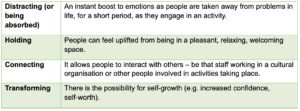The role of the cultural sector in social prescribing for older people through the Covid-19 pandemic
Social prescribing connects people to community support through a range of activities usually provided by the voluntary or community sector. For example, volunteering, gardening, cookery, arts activities, befriending, healthy eating advice and physical activity.
Early evidence shows that social prescribing can have a positive impact on life satisfaction, happiness and sense of purpose, and can reduce anxiety. More research is needed in this area however, which is why the What Works Centre for Wellbeing has supported a secondment to the National Academy of Social Prescribing.
As part of the further research into the effectiveness of social prescribing, a team from Oxford, Plymouth and UCL were funded by the Arts and Humanities Research Council to address the question: Cultural institutions as social prescribing venues to improve older people’s well-being in the context of the Covid-19 pandemic: What works, for whom, in what circumstances and why? Two of the researchers outline here what they found…
The Covid-19 pandemic has challenged our health and well-being in multiple ways. As restrictions on social contact came into force, technological advances enabled people to interact differently. Numerous cultural activities were transferred online, from singing and dancing, to tours of museums and art galleries. Offline provision also continued where it could to avoid excluding people who lacked access to a computer or the internet.
Cultural activities have helped all age groups during the pandemic, including older people who were particularly vulnerable to the physical health implications of Covid-19 and its social impact. Our experiences during the pandemic allow us to take some of these cultural provisions forward, for example through social prescribing.
What is social prescribing?
Social prescribing involves connecting people to community assets – groups, organisations, clubs, charities – that can address their non-medical issues, with link workers acting as bridges to these community assets. Link workers meet with individuals who have either been referred to them through a health professional or who have self-referred, talk to them about their needs and problems, and create an action plan. Part of an action plan may entail linking people to things within the cultural sector such as:
- Visiting a botanical garden to hear a talk on a certain type of plant
- Attending an in-person or online book group through a library
- Going to a museum to see behind the scenes and take part in the handling of objects
- Volunteering at a cultural organisation
Our findings
Our research consisted of a review of existing literature, followed by interviews with older people and cultural sector staff, and a questionnaire completed by link workers. We gathered the data to help us develop and revise a programme theory – an explanation that addressed the various elements of our research question. We have produced several blogs on this research.
We developed a programme theory centred on the idea of ‘tailoring’. This refers to producing and fashioning an intervention and its distribution (in our case, cultural activities offered through social prescribing), to meet the needs of recipients (in our case, older people aged 60+), which reflects environmental and social circumstances. We propose that tailoring is key to:
- Encouraging an older person to accept the idea of engaging with a cultural offer
- Producing cultural offers that they find accessible and appropriate to their needs
We identified the following elements to tailoring in our research:

Through tailoring, our research suggested that older people can garner the following benefits from engaging with a cultural offer:

Next steps
We are in the process of developing a set of recommendations from the research for link workers, for cultural sector staff and for older people that reflect our findings and our conversations with stakeholders.
We will publish our final recommendations and final programme theory, when ready, on our website. We welcome any comments you have to make on this research.
